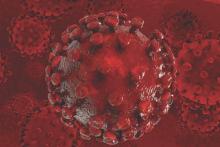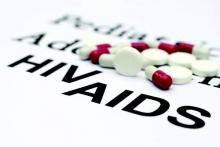A landmark study in France has demonstrated that preexposure prophylaxis (PrEP) antiretroviral therapy offers protection against HIV-1 infection among HIV-negative men at high risk of infection.
Researchers in the IPERGAY trial, a double-blind, randomized, placebo-controlled study of 400 men who have sex with men (MSM), provided PrEP combination therapy to the study participants using tenofovir disoproxil fumarate (TDF) and emtricitabine (FTC) before and after unprotected anal sex. Two of 199 men without HIV infection who received the active prophylaxis contracted HIV during a median of 9.3 months follow-up (incidence, 0.91/100 person-years), compared with 14 of 201 who received placebo (incidence, 6.60/100 person-years; relative reduction, 86%), Dr. Jean-Michel Molina of Saint-Louis Hospital and the University of Paris, and his colleagues reported online Dec. 1 in the New England Journal of Medicine.
Trial subjects were men at high risk for HIV-infection because of self-reported, unprotected anal sex. They were randomized to receive active TDF-FTC treatment or placebo taken both before and after sexual activity. All study participants also received risk-reduction counseling and condoms (N Engl J Med. 2015 Dec. 1;373:2237-46. doi: 10.1056/NEJMoa1506723).
Subjects in both groups took a median of 15 pills per month. Active treatment was prescribed at a fixed dose of 300 mg TDF and 200 mg FTC per pill, given as a loading dose of two pills or placebo with food 2-24 hours before sex, followed by a third pill 24 hours later, and a fourth pill another 24 hours later. In the case of multiple consecutive episodes of sexual intercourse, one pill daily was prescribed until the last encounter, followed by two postexposure pills. Postexposure prophylaxis in the latter incidence was provided as a loading dose of two pills unless the last drug intake was less than a week prior, in which case only one pill was taken. Adherence was measured by pill count and plasma drug levels.
The rates of grades 3 and 4 serious adverse events were similar in the groups, although those in the TDF-FTC group experienced higher rates of gastrointestinal events (14% vs. 5%) and renal adverse events (18% vs. 10%).
Testing the value of PrEP
Preexposure prophylaxis has been considered a promising intervention for preventing HIV-1 infection, but findings from recent studies have been conflicting, possibly because of low adherence, the IPERGAY investigators said.
Another trial, the Preexposure Prophylaxis Initiative (iPrex) trial, showed a moderate relative reduction of 42% in HIV-1 incidence when TDF-FTC was used daily, they noted. (N Engl J Med. 2010 Dec. 30;363:2587-99. doi: 10.1056/NEJMoa1011205).
The IPERGAY trial (the Intervention Préventive de l’Exposition aux Risques avec et pour les Gays), assessed the efficacy and safety of sexual activity–dependent PrEP with TDF-FTC, based on a hypothesis that adherence – and thus efficacy – might be higher than with a daily regimen.
“The two participants in the TDF-FTC group in whom HIV-1 infection was diagnosed at scheduled visits returned 60 and 58 pills out of 60, respectively ... and were therefore deemed to be nonadherent to preexposure prophylaxis. Study drugs were not detected in plasma samples obtained from these two participants at the time of HIV-1 diagnosis,” the investigators wrote.
The findings of this study are among the highest-risk reductions that have been reported to date, but short follow-up “may have increased the likelihood of an exaggerated estimate of efficacy,” they noted.
Also, the results cannot be extrapolated to those who have less-frequent sexual intercourse, who would thus be taking TDF-FTC on a more intermittent regimen than was seen in this trial, they said.
The findings nonetheless suggest there is value in PrEP with TDF-FTC.
“While we wait for an effective vaccine against HIV, the use of such preexposure prophylaxis with TDF-FTC among high-risk men could contribute to a reduced incidence of HIV infection,” they concluded.
Time for action
In an accompanying editorial, Dr. Anthony S. Fauci and Dr. Hilary D. Marston of the National Institute of Allergy and Infectious Diseases, said the results of the IPERGAY trial, taken together with those of prior studies, “have shown definitively that the benefits of prompt initiation of [antiretroviral therapy] – regardless of the CD4+ T-cell count – outweigh the risks, for both the infected person and uninfected sexual partners and that PrEP can be implemented in a way that is both acceptable to patients and safe and effective in blocking HIV transmission” (N Engl J Med. 2015 Dec. 1;373:2197-99. doi: 10.1056/NEJMp1502020).
IPERGAY provides important new data that support the use of PrEP for preventing HIV infection in high-risk populations, and the existing data provide an “evidence-based blueprint for effective treatment and prevention of HIV infection and will serve as critical tools in the fight to end the HIV-AIDS pandemic,” Dr. Fauci and Dr. Marston wrote, adding that “the political will must be mobilized to match the scientific evidence and provide the financial and human resources necessary to dramatically scale up HIV testing and treatment around the world.”



